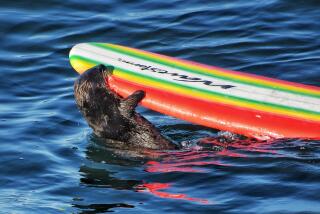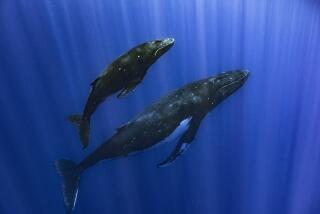‘Hah!’ Giant river otters are real chatterboxes, scientists find
- Share via
Giant otters sure have a lot to say. Scientists who studied the river-living animals in captivity and in the wild found that the adults have 22 different calls they use for different situations – and the babies have 11 calls of their own, too.
The findings, published in the journal PLOS ONE, show that this rich system of communication is likely linked to the animals’ complex social structure.
Giant otters, Pteronura brasiliensis, live in South America, mostly along the Amazon River and the wetlands of the Pantanal. A typical family will consist of a male-female mating pair and their offspring from different years. The adults share their food with the pups when they’re young, and over time teach them how to hunt on their own.
This species is part of the family that includes weasels, but they’re sometimes called river wolves, and with good reason: The animals can grow longer than 5.5 feet, and -- unlike other weasel relatives -- live in highly social groups. They’re also very chatty, as the scientists who performed this study showed.
The scientists studied groups of otters at three zoos in Germany and also at five oxbow lakes in Peru. They kept their distance, coming no closer than 10-50 meters away in the wild, watching their behavior and recording the sounds they made.
The adults had a wide repertoire of sounds, the authors found, from hums to screams to a sound they simply called “Hah!” And each served different purposes, depending on the context. A hum could soothe group members in social interactions, while a “hum gradation” could signal that a group of otters was changing direction. A growl would be used to issue a threat or warning (typically to defend a fresh-caught fish), and a “Hah!” could be a warning of oncoming danger.
The recently born babies (known as neonates) also had their own calls -- some of which were shared with the adults. The young otters’ calls were interspersed in their bouts of babbling.
“Infant babbling can enhance the development of the full adult vocal repertoire by providing ample opportunity for practice,” the study authors wrote.
But some of the infants’ calls also have another purpose: whining for food. Until these “neonates” are old enough to learn how to hunt, they beg the older otters to share with them -- so having a persuasive set of calls that say “give me food” or “take care of me” is crucial to survival.
“The giant otters’ social complexity seems to be reflected in their vocal complexity,” the study authors wrote. “Neonate vocalizations were also complex and included precursors of the adult repertoire, as well as age-specific calls, supporting our hypotheses on the vocal repertoire of neonate giant otters.”
Giant river otters are listed as endangered under the red list of threatened species, published by the International Union for Conservation of Nature. And these findings, the authors said, should allow researchers to better understand these charismatic animals.
“We hope that this detailed account of the giant otters’ vocal repertoire will help to facilitate conservation efforts of this endangered species,” the study authors wrote. “By providing the behavioural context and acoustic measures of the vocalizations, the otters’ arousal or stress in a given situation may be easier to evaluate.”
Did you know that a group of otters can be called a “romp” of otters? Follow @aminawrite for more science news.







